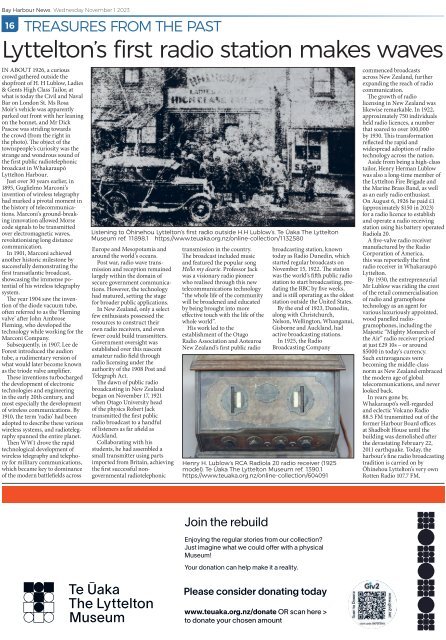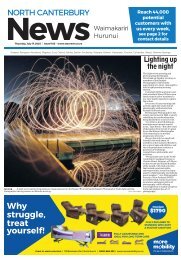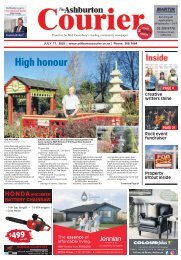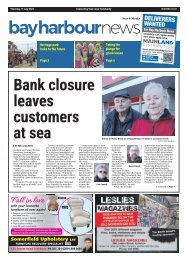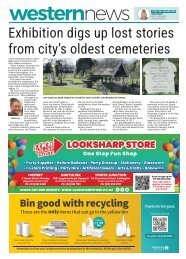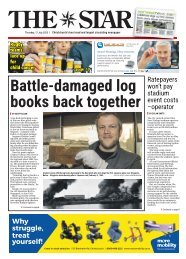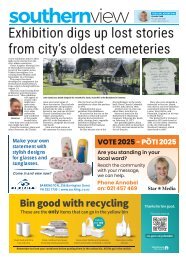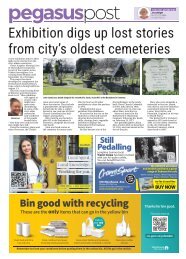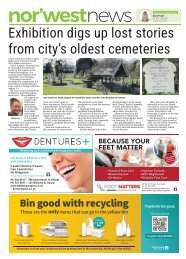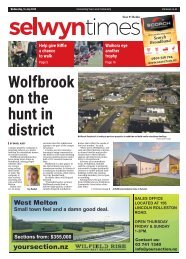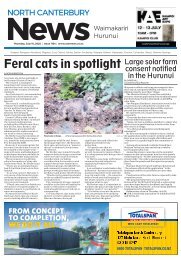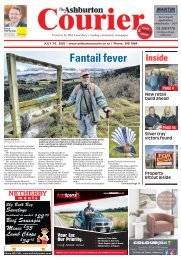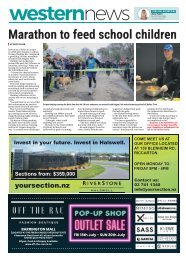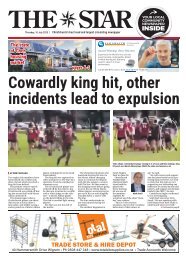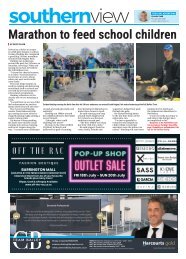Bay Harbour: November 01, 2023
Transform your PDFs into Flipbooks and boost your revenue!
Leverage SEO-optimized Flipbooks, powerful backlinks, and multimedia content to professionally showcase your products and significantly increase your reach.
<strong>Bay</strong> <strong>Harbour</strong> News Wednesday <strong>November</strong> 1 <strong>2023</strong><br />
16<br />
TREASURES FROM THE PAST<br />
Lyttelton’s first radio station makes waves<br />
IN ABOUT 1926, a curious<br />
crowd gathered outside the<br />
shopfront of H. H Lublow, Ladies<br />
& Gents High Class Tailor, at<br />
what is today the Civil and Naval<br />
Bar on London St. Ms Rosa<br />
Moir’s vehicle was apparently<br />
parked out front with her leaning<br />
on the bonnet, and Mr Dick<br />
Pascoe was striding towards<br />
the crowd (from the right in<br />
the photo). The object of the<br />
townspeople’s curiosity was the<br />
strange and wondrous sound of<br />
the first public radiotelephonic<br />
broadcast in Whakaraupō<br />
Lyttelton <strong>Harbour</strong>.<br />
Just over 30 years earlier, in<br />
1895, Guglielmo Marconi’s<br />
invention of wireless telegraphy<br />
had marked a pivotal moment in<br />
the history of telecommunications.<br />
Marconi’s ground-breaking<br />
innovation allowed Morse<br />
code signals to be transmitted<br />
over electromagnetic waves,<br />
revolutionising long distance<br />
communication.<br />
In 19<strong>01</strong>, Marconi achieved<br />
another historic milestone by<br />
successfully demonstrating the<br />
first transatlantic broadcast,<br />
showcasing the immense potential<br />
of his wireless telegraphy<br />
system.<br />
The year 1904 saw the invention<br />
of the diode vacuum tube,<br />
often referred to as the ‘Fleming<br />
valve’ after John Ambrose<br />
Fleming, who developed the<br />
technology while working for the<br />
Marconi Company.<br />
Subsequently, in 1907, Lee de<br />
Forest introduced the audion<br />
tube, a rudimentary version of<br />
what would later become known<br />
as the triode valve amplifier.<br />
These inventions turbocharged<br />
the development of electronic<br />
technologies and engineering<br />
in the early 20th century, and<br />
most especially the development<br />
of wireless communications. By<br />
1910, the term ‘radio’ had been<br />
adopted to describe these various<br />
wireless systems, and radiotelegraphy<br />
spanned the entire planet.<br />
Then WW1 drove the rapid<br />
technological development of<br />
wireless telegraphy and telephony<br />
for military communications,<br />
which became key to dominance<br />
of the modern battlefields across<br />
Listening to Ōhinehou Lyttelton’s first radio outside H.H Lublow’s. Te Ūaka The Lyttelton<br />
Museum ref. 11898.1 https://www.teuaka.org.nz/online-collection/1132580<br />
Europe and Mesopotamia and<br />
around the world’s oceans.<br />
Post war, radio wave transmission<br />
and reception remained<br />
largely within the domain of<br />
secure government communications.<br />
However, the technology<br />
had matured, setting the stage<br />
for broader public applications.<br />
In New Zealand, only a select<br />
few enthusiasts possessed the<br />
resources to construct their<br />
own radio receivers, and even<br />
fewer could build transmitters.<br />
Government oversight was<br />
established over this nascent<br />
amateur radio field through<br />
radio licensing under the<br />
authority of the 1908 Post and<br />
Telegraph Act.<br />
The dawn of public radio<br />
broadcasting in New Zealand<br />
began on <strong>November</strong> 17, 1921<br />
when Otago University head<br />
of the physics Robert Jack<br />
transmitted the first public<br />
radio broadcast to a handful<br />
of listeners as far afield as<br />
Auckland.<br />
Collaborating with his<br />
students, he had assembled a<br />
small transmitter using parts<br />
imported from Britain, achieving<br />
the first successful nongovernmental<br />
radiotelephonic<br />
transmission in the country.<br />
The broadcast included music<br />
and featured the popular song<br />
Hello my dearie. Professor Jack<br />
was a visionary radio pioneer<br />
who realised through this new<br />
telecommunications technology<br />
“the whole life of the community<br />
will be broadened and educated<br />
by being brought into more<br />
effective touch with the life of the<br />
whole world”.<br />
His work led to the<br />
establishment of the Otago<br />
Radio Association and Aotearoa<br />
New Zealand’s first public radio<br />
broadcasting station, known<br />
today as Radio Dunedin, which<br />
started regular broadcasts on<br />
<strong>November</strong> 15, 1922. The station<br />
was the world’s fifth public radio<br />
station to start broadcasting, predating<br />
the BBC by five weeks,<br />
and is still operating as the oldest<br />
station outside the United States.<br />
By the end of 1923, Dunedin,<br />
along with Christchurch,<br />
Nelson, Wellington, Whanganui,<br />
Gisborne and Auckland, had<br />
active broadcasting stations.<br />
In 1925, the Radio<br />
Broadcasting Company<br />
Henry H. Lublow’s RCA Radiola 20 radio receiver (1925<br />
model). Te Ūaka The Lyttelton Museum ref. 1390.1<br />
https://www.teuaka.org.nz/online-collection/604091<br />
commenced broadcasts<br />
across New Zealand, further<br />
expanding the reach of radio<br />
communication.<br />
The growth of radio<br />
licensing in New Zealand was<br />
likewise remarkable. In 1922,<br />
approximately 750 individuals<br />
held radio licences, a number<br />
that soared to over 100,000<br />
by 1930. This transformation<br />
reflected the rapid and<br />
widespread adoption of radio<br />
technology across the nation.<br />
Aside from being a high-class<br />
tailor, Henry Herman Lublow<br />
was also a long-time member of<br />
the Lyttelton Fire Brigade and<br />
the Marine Brass Band, as well<br />
as an early radio enthusiast.<br />
On August 6, 1926 he paid £1<br />
(approximately $150 in <strong>2023</strong>)<br />
for a radio licence to establish<br />
and operate a radio receiving<br />
station using his battery operated<br />
Radiola 20.<br />
A five-valve radio receiver<br />
manufactured by the Radio<br />
Corporation of America,<br />
this was reportedly the first<br />
radio receiver in Whakaraupō<br />
Lyttelton.<br />
By 1930, the entrepreneurial<br />
Mr Lublow was riding the crest<br />
of the retail commercialisation<br />
of radio and gramophone<br />
technology as an agent for<br />
various luxuriously appointed,<br />
wood panelled radiogramophones,<br />
including the<br />
Majestic “Mighty Monarch of<br />
the Air” radio receiver priced<br />
at just £29 10s – or around<br />
$5000 in today’s currency.<br />
Such extravagances were<br />
becoming the middle-class<br />
norm as New Zealand embraced<br />
the modern age of global<br />
telecommunications, and never<br />
looked back.<br />
In years gone by,<br />
Whakaraupō’s well-regarded<br />
and eclectic Volcano Radio<br />
88.5 FM transmitted out of the<br />
former <strong>Harbour</strong> Board offices<br />
at Shadbolt House until the<br />
building was demolished after<br />
the devastating February 22,<br />
2<strong>01</strong>1 earthquake. Today, the<br />
harbour’s fine radio broadcasting<br />
tradition is carried on by<br />
Ōhinehou Lyttelton’s very own<br />
Rotten Radio 107.7 FM.<br />
Join the rebuild<br />
Enjoying the regular stories from our collection?<br />
Just imagine what we could offer with a physical<br />
Museum!<br />
Your donation can help make it a reality.<br />
Please consider donating today<br />
www.teuaka.org.nz/donate OR scan here ><br />
to donate your chosen amount


